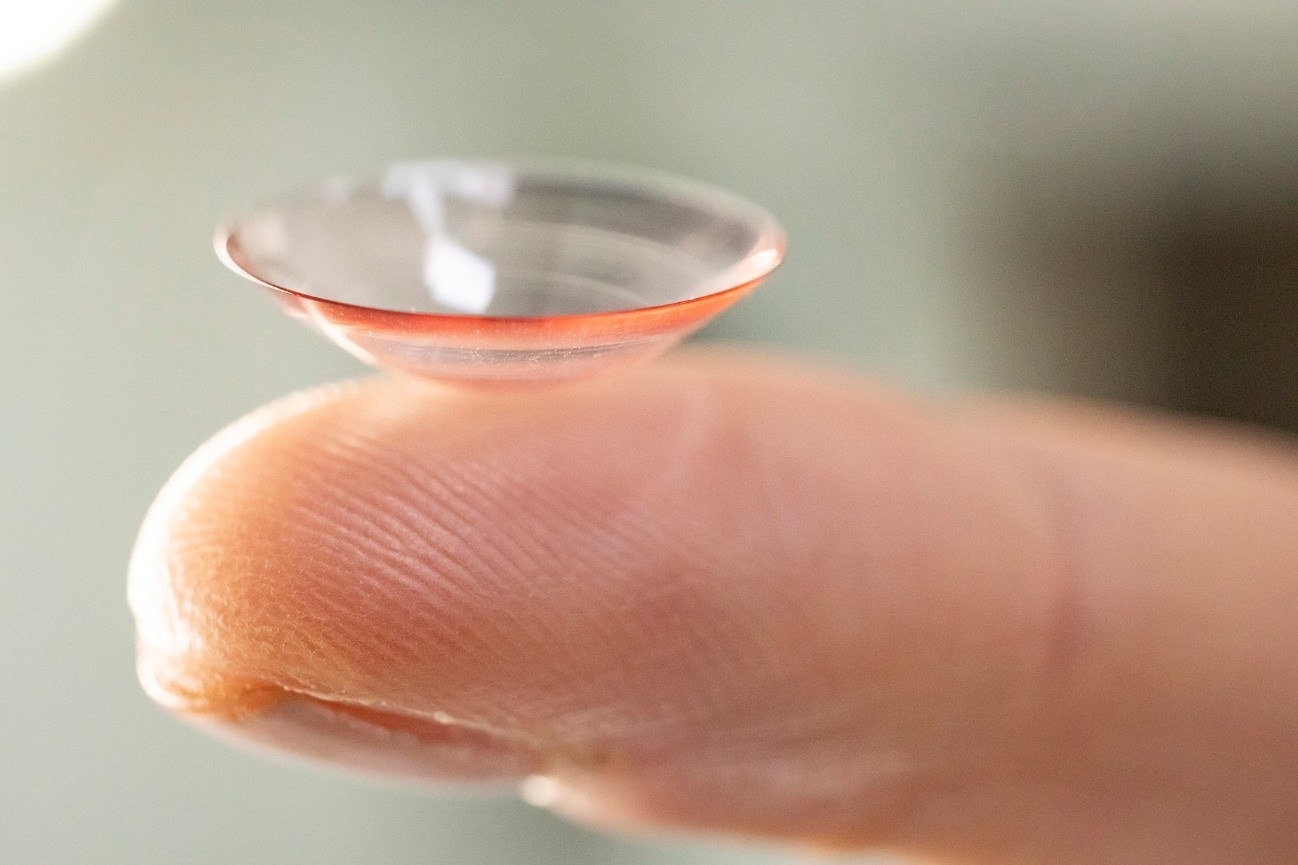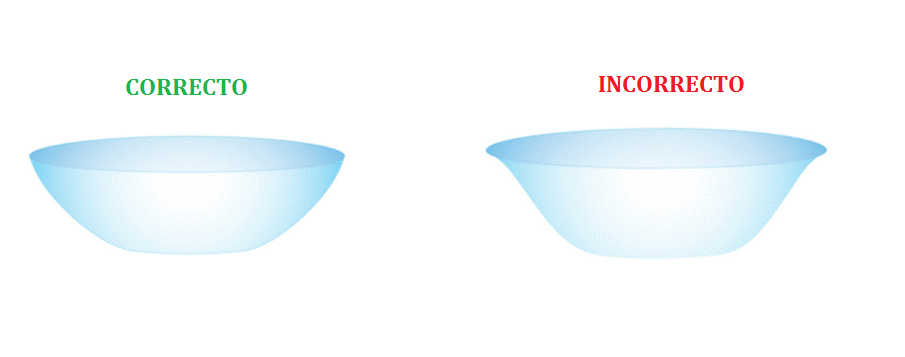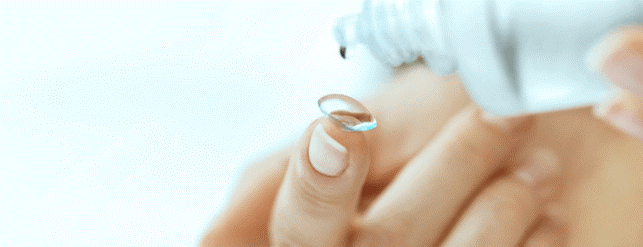
Contact lenses are curved lenses that are placed on the surface of the eye with the purpose of correcting visual defects. These lenses are graduated according to the patient’s needs and are usually transparent, although in some cases they contain a slight touch of color to facilitate their placement.
The use of contact lenses is becoming more and more frequent in our environment. According to the Spanish Vision White Paper, it is estimated that around 7.4% of the Spanish population between the ages of 12 and 65 wears contact lenses. This number represents about 2.5 million people.
It is important to know the different types of lenses and the injuries they can cause if not used properly.
There are different types of lenses depending on the case of each patient and visual defect to be corrected:
Soft contact lenses: They are used to compensate mild refractive errors in patients with myopia, hyperopia and astigmatism. This type of lens is usually made of hydrogel and new advances, such as silicone lenses, allow more oxygen to reach the eye, preventing eye irritation.
Rigid contact lenses: they are smaller, harder and less flexible than soft ones. They are used in patients with high astigmatism or in cases with corneal irregularities.
Scleral or semi-scleral contact lenses: they are advisable for patients with severe dry eye as they are larger and stiffer and can be filled with artificial tear, which allows the eye to be permanently moist
Orto-k: They are lenses that are placed during the night and are indicated for patients with myopia, hyperopia or astigmatism. This type of lenses have a shaping effect on the cornea during the night, while we sleep, so that when the patient removes them in the morning they can see well throughout the day without having to wear glasses or contact lenses.
Depending on the recommended time of use, we can also classify them as daily, biweekly, monthly or long-term.
To correctly wear contact lenses and avoid possible damage or infection, the following steps should be followed:
In case you have the same prescription in both eyes, the placement in the left or right eye is irrelevant. If you have a different prescription in each eye, the optician will provide you with two boxes, one labeled as left eye (LE) and the other as right eye (RE).
3. Place the lens on the forefinger of your hand to check that the lens is clean and not upside down.
How do I know if the contact lenses are in the right or upside down position?
Once placed on the forefinger, the shape of the lens will indicate whether it is upside down or right-side up. The ophthalmologist will be able to help you identify it correctly at the time of the first fitting.

4. Hold the upper eyelid with the middle finger of the other hand and the lower eyelid with the middle finger of the hand holding the contact lens.
5. Place the contact lens on the eye while looking upwards.
6. Once the contact lens is in place, remove your finger and gradually release the lower eyelid and then the upper eyelid.
With contact lenses in, you can enjoy corrected vision without glasses.
It is important to correctly follow the instructions of our ophthalmologist or optician, in addition to the instructions provided by the manufacturer of the lenses. Incorrect use of contact lenses can cause visual conditions with serious consequences for our vision.
To remove the contact lens correctly, follow these steps:
Contact lenses can lead to irritations, allergies, injury by rubbing and infections. This will depend on the type of lens, the hygiene and the cure that we have of the products that are used to clean and the manipulation of the lenses made when we used them.
It is rare that allergies are produced by the material of the lens (it is rare). The most common is due to the accumulation of the deposits that are formed and the preservatives dissolved in the cleaning products.
Corneal abrasions (scratches or rubbing) give rise to intense pain with tearing, ocular redness, discomfort to light, foreign body sensation and intolerance to the lens (shape, measurement, etc.) or alterations of the lens by notches or breaks.
The symptoms of blurred vision, halos of colours and intolerance to the lens (reddish, foreign body sensation, tearing, etc.) can appear if the lenses are worn too long.
Infections are usually rare, but they can be very dangerous and cause loss of vision in the eye.
Contact lenses require good care, since an expired contact lens or one with insufficient or incorrect hygiene can cause scratches on the cornea (corneal abrasions), allergy (depending on the manufacturing material) or infections.
For this reason it is important to follow the steps below:

Contact lenses also require some care, especially when they are used for going to the beach or swimming pool. In such cases, there are several things to keep in mind:
Contact lenses can lead to irritations and allergies, rubbing injuries and infections. This will depend on the type of lens, the hygiene and care we take (breakage, deposits, etc.), the products used for cleaning and the handling of the lenses when inserting them.
Allergies can be caused by the lens material (this is rare), but most commonly by the accumulation of deposits that form and by the preservatives dissolved in the cleaning products.
Corneal abrasions (scratches or grazes) result in severe pain with tearing, ocular redness, light discomfort, foreign body sensation and intolerance to the lens (shape, size, etc.), as well as alterations of the lens due to nicks or tears.
Symptoms of blurred vision, color halos and lens intolerance (red eye, foreign body sensation, tearing, etc) may appear if the lenses are worn for an excessive amount of time.
Infections are usually rare, but can be very dangerous and cause loss of vision in the eye.
In addition, external agents such as heat or the chemical substances contained in swimming pool water and sea salt in summer often cause irritative, viral or bacterial conjunctivitis, which can manifest with symptoms such as eye redness, stinging, burning, foreign body sensation, hypersensitivity to light or tearing.

In general, any healthy person with refractive problems can wear contact lenses. However, there are cases in which lenses are not recommended, such as patients with severe allergies, people who work in dusty environments, patients with dry eyes or people who are not able to take proper care of the lenses.
There are multiple factors that can favor the appearance of an eye infection due to contact lens use. Some of them are prolonged use of the lenses, lack of tears, lack of hygiene or external factors that may alter the condition of the eye and the lens.
Keratitis (inflammation of the cornea) can be caused by different elements, such as bacteria, fungi and, above all, microbes like acanthamoeba, which is very common among contact lens wearers and causes an infection that is difficult to treat. In the most serious cases it can cause scarring of the cornea and lead to vision problems that require a corneal transplant. It is very important to maintain good lens hygiene to avoid this type of infection.
Not all eye drops are suitable for contact lenses, as unsuitable drops can cause serious corneal infections. It is important that if you need moisturizing eye drops, they are prescribed by your ophthalmologist.
Cosmetic contact lenses should not be purchased from non-specialized sources. Colored cosmetic contact lenses or contact lenses for costumes should never be purchased in non-specialized centers. The supervision and prescription of an ophthalmologist is necessary for any type of contact lenses, since they will be in contact with the eye and their safety must be guaranteed.
There are different types of contact lenses and each has a specific lifetime, which can be daily, biweekly, monthly or long-term. To determine the renewal of your lenses, you should consult your optician to determine which type you have.
Contact lenses are not recommended if you have conjunctivitis or stye. It is important to remove contact lenses immediately if symptoms of conjunctivitis appear, since the use of lenses can worsen the infection. It is also important to wait to put contact lenses back in until the condition is completely cured.
There is no minimum age for wearing contact lenses, since their use depends on the anatomical characteristics and refractive problems of each patient.
There is no scientific evidence of a link between contact lens wear and coronavirus. However, experts recommend extreme hygiene measures such as hand washing to avoid transmission of the virus.
Contact us or request an appointment with our medical team.